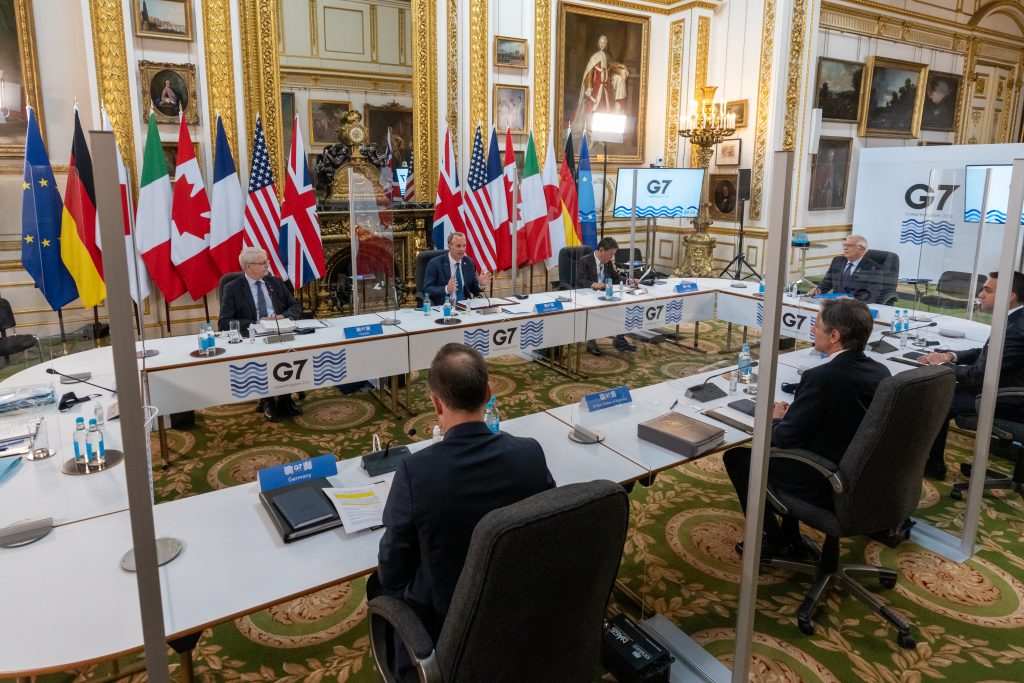From the G7 to a D-10: Strengthening democratic cooperation for today’s challenges
As the world emerges from a devastating pandemic, the United States and its democratic allies and partners face a daunting array of global threats and challenges. Authoritarianism is rising, Iran and North Korea continue to advance their nuclear programs, and the race for advanced technologies is heating up. Climate change is irreversibly altering the planet, while wage stagnation and unemployment threaten to derail the makings of a global economy recovery.
More profoundly, the world is entering new era of strategic competition. For the first time in more than three decades, the United States and its allies face a systemic challenge from autocratic rivals that seek to disrupt or displace the rules-based democratic order. As President Joe Biden highlighted during his remarks to the Munich Security Conference in February, the world is in the midst of a fundamental debate—an inflection point—between “those who argue that autocracy is the best way forward” and “those who understand that democracy is essential to meeting [today’s] challenges.”
China is growing more powerful and Russia more assertive in challenging key tenets of the global system, each in their own ways but increasingly aligned, as they engage in coercive tactics to expand their influence. Meanwhile, democracies are on the defensive as they seek to contend with these global threats even as many, including the United States, face deeply polarized electorates and growing political dysfunction at home.
The D-10 can serve to drive a common approach to counter the wide range of autocratic threats posed by Russia and China. It can forge a technology initiative to develop common norms and standards for advanced technologies and more resilient supply chains. It can provide a channel for rebuilding commitments to free and fair trade, and a new climate initiative to collectively advance green technologies.
To position themselves to succeed in this new era, the United States and its democratic allies and partners will need new means to strengthen cooperation. They need institutions, formal and informal, that are fit for purpose, and reflect the evolving global distribution of power and nature of today’s challenges. While many institutions created after World War II, including NATO, continue to play an important role in convening democracies, others, such as the Group of Seven (G7), require adaptation to address the challenges of today’s world. The United States and its allies need to update existing entities or create new ones to facilitate deeper cooperation among the world’s democracies.
With the rules-based democratic order under threat, leading democracies need to develop common strategic approaches that pool their collective influence to confront today’s challenges. To this end, this paper proposes a formal Democracies Ten—a “D-10”—aimed at fostering strategic alignment and coordinated action among a group of like-minded, influential democracies to advance a rules-based democratic order.
Membership in the D-10 would be based on criteria identifying a select group of nations that are strategically likeminded and have also demonstrated a capacity for global influence. The resulting group would bring together the current members of the G7, including the European Union, plus Australia and South Korea. In addition, the D-10 could include—though not necessarily from the outset— India, South Africa, and/or Brazil, if concerns over like-mindedness can be overcome. With about 60 percent of global gross domestic product (GDP), a new D-10 would serve as a powerful mechanism to align the world’s most influential democracies around a coordinated set of strategies to address global challenges.

The D-10 can serve to drive a common approach to counter the wide range of autocratic threats posed by
Russia and China. It can forge a technology initiative to develop common norms and standards for advanced technologies and more resilient supply chains. It can provide a channel for rebuilding commitments to free and fair trade, and a new climate initiative to collectively advance green technologies. A D-10 can organize collective strategies to counter authoritarianism and support democratic movements around the world. And it can facilitate a common approach to nuclear proliferation by Iran and North Korea, and coordinate defense strategies and military investments across the free world.
While the concept of a D-10 was developed more than a decade ago, it has recently risen to the top of the global agenda and has garnered widespread interest. British Prime Minister Boris Johnson signaled his support for the idea by inviting the leaders of Australia, South Korea, India, and, more recently, South Africa, to the June G7 summit. Separately, President Biden has called for revitalizing cooperation with democratic allies, and is seeking to organize a Summit for Democracy next year. And, several other leaders, including German Chancellor Angela Merkel, have called for closer democratic cooperation on challenges, including those posed by China and Russia. While there are differing views among governments on the merits and format of a D-10, the concept has gained increasing support among policymakers in the United States and other leading democracies.
This paper describes the strategic context and rationale for the creation of a D-10, its potential mission and membership, and how it would be organized. It proposes specific areas around which to prioritize action and practical steps to realize this entity, given the current views of potential members. The paper also addresses concerns about the D-10, including how to avoid perceptions that this will lead to a more polarized world or a new Cold War-like confrontation among great powers. Finally, it suggests that while there may be some duplication of effort between the two, it may be politically advantageous to retain the G7 for now, while simultaneously creating a D-10. A transition away from the G7 and toward a D-10 may take place gradually as the framework proves effective and meaningful over time.
The D-10 is not intended as a security alliance or an alternative to the United Nations (UN) Security Council, nor is it directed at confronting or containing China or any other nation. Rather, it is aimed at rallying the world’s most powerful democracies around a common cause—advancing a rules-based democratic order based on shared values and common interests. The overarching strategic challenge facing the United States and other democracies is whether they can preserve a rules-based democratic order that reflects these values, or “whether the world will slip back toward a state in which illiberal regimes and coercive practices are ascendant.”
Lead authors
In collaboration with
- Tobias Bunde, Director of Research and Policy at the Munich Security Conference
- Sophia Gaston, Director of the British Foreign Policy Group
- Yuichi Hosoya, Professor of International Relations at Keio University

